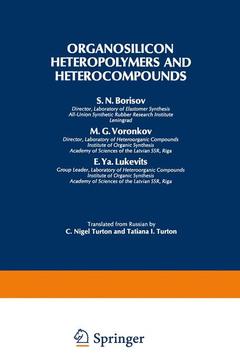Description
Organosilicon Heteropolymers and Heterocompounds, Softcover reprint of the original 1st ed. 1970
Monographs in Inorganic Chemistry Series
Author: Borisov S. N.
Language: English
Subject for Organosilicon Heteropolymers and Heterocompounds:
Publication date: 12-2012
634 p. · 15.2x22.9 cm · Paperback
634 p. · 15.2x22.9 cm · Paperback
Description
/li>Contents
/li>
There are numerous criteria for measuring the growth and development of branches of chemistry. This valuable book illustrates a particular aspect of the growth of organosilicon chemistry. The extent of this field has developed so greatly in recent years that it now is desirable to reclassify parts to bring together hitherto frag mented and relatively disparate sections. This has been accomplished by the presently available large units which have been deSignated as "organosilicon heterocompounds. " Simplified expressions of such classification are structural units of the general type C - Si - heteroelement and heteroelement-C - Si, in which there are attached to the organosilicon moiety elements such as oxygen, nitrogen, metals, etc. This arrangement per mits the correlation of extensive material, which will be invalu able to chemists in many areas, both in and out of organosi- con chemistry. Because of the wealth of information, the authors are currently engaged in the preparation of companion volumes arranged on this general principle. The scope is broad, and includes material which will prove highly interesting and useful to those in academic, industrial, and governmental circles. There is not only a wide coverage of the literature generally, but the listings of patent references and of general reviews and books are among the most complete so far presented.
1 Organosilicon Compounds of Group I Elements.- 1. Compounds Containing the Si—M Bond.- 2. Compounds Containing the Si —(C)n—M Group.- 3. Compounds Containing the Si—N—M Group.- 4. Compounds Containing the Si—O—M Group (Silanolates of Alkali Metals).- 5. Compounds Containing the Si—S—M Group.- 6. Organosilicon Derivatives of Copper and Silver.- 2 Organosilicon Compounds of Group II Elements.- 1. Compounds Containing the Si—O—M Group.- 2. Compounds Containing the Si—M Group.- 3. Compounds Containing the Si—(C)n—M Group.- 4. Compounds Containing the Si—N—M Group.- 5. Salts of Silicoorganic Acids.- 6. Complexes of Halosilanes and Other Organosilicon Compounds with Halides of Group II Elements.- 3 Organosilicon Compounds of Group III Elements.- Boron.- Aluminum.- 4 Organosilicon Compounds of Group IV Elements.- Germanium.- Tin.- Lead.- Titanium.- Zirconium and Hafnium.- 5 Organosilicon Compounds of Group V Elements.- Arsenic.- Antimony.- Bismuth.- Vanadium.- Niobium and Tantalum.- 6 Organosilicon Compounds of Group VI Elements.- Selenium and Tellurium.- Elements of the Chromium Subgroup.- 7 Organosilicon Compounds Of Elements Of The Manganese Subgroup.- 1. Organosilicon Derivatives of Manganese.- 2. Organosilicon Derivatives of Rhenium.- 3. Properties and Application of Organosilicon Compounds of Elements of the Manganese Subgroup.- 8 Organosilicon Compounds of Group VIII Elements.- 1. Compounds Containing the Si—O—Fe Group.- 2. Organosilicon Derivatives of Ferrocene.- 3. Organosilicon Derivatives of Iron Containing Nitrogen.- 4. Complex Salts of Iron with Organosilicon Compounds.- 5. Organosilicon Derivatives of Cobalt and Nickel.- 6. Organosilicon Compounds of Other Group VIII Elements.- Literature Cited.- 1. Monographs, Reviews, andDissertations.- 2. Articles and Reports of Russian Authors.- 3. Articles and Reports of Foreign Authors.- 4. Author’s Certificates and Patents.
© 2024 LAVOISIER S.A.S.




